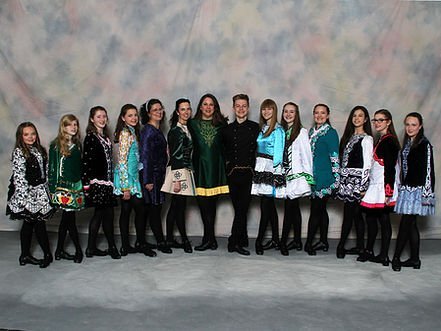Parent Resources & FAQs
Parent Resources & FAQs
This page is for our parents and families! We have a page for dancers, too. We will compile resources and answers to questions here as they arise. If you have a question that isn’t answered here, just drop us a line!
Acronyms and abbrevations:
WIDA = World Irish Dance Association
HOI = Heart of Ireland School of Dance
The shoes: Irish dancers have 2 different types of shoes. Dancers start in soft shoes, also called ghillies (pronounced “gi-leez” with a hard g). Ghillies are a leather shoe with loops or fingers through which laces are threaded. How do you lace them up? After several months to a year of learning, they will start learning hard shoe dances. Hard shoes are often called jig shoes or heavy shoes. Occasionally they are referred to as hornpipe shoes. Jig shoes have a leather upper, laces similar to a man’s dress oxford, a strap over the ankle and fiberglass or resin tips and heels. Jig shoes do NOT have taps on them. Taps are metal plates screwed onto a shoe and that is something different indeed. There are many brands of shoes to choose from, depending on the shape of your dancer’s foot. We’ve listed our authorized and preferred brands on our There also may be used shoes available – check the used shoe shelves in the studio to see if there’s a pair that will fit your dancer.
The dances: Reels, jigs and hornpipes are names for all of the types of dances we do! Reels are dances performed to music written in 2/2 or 4/4 time. Reels are done in soft shoe AND in hard shoe. Soft shoe reels are one of the first types of steps a dancer learns. Hard shoe reels are called treble reels. These are most often done in show or freestyle dancing. They are lively, vibrant dances that can be done to most music and are quite rousing!
Jigs can be done in soft or hard shoes. Most jigs are dances performed to music written in 6/8 time; the exception to this is slip jigs, which are performed to music written in 9/8 time. Soft shoe jigs are light jigs and single jigs (performed by both male and female dancers) and slip jigs (performed by females only). Hard shoe jigs are called treble jigs and can be performed at a traditional speed (usually around 92 beats per minute) or ‘slow’ speed (around 72-76 beats per minute). Dancers start learning treble jigs at traditional speed and progress to slow speed at the Prizewinner level.
Hornpipes are only done in hard shoe. They are performed to music written in 2/4 time and the emphasis of the steps and rhythm is different from that done in treble reels.
Set dances are hard shoe dances performed to a specific piece of music. There are traditional and non-traditional set dances. Traditional set dances are dances where the same steps are always done to that piece of music. Non-traditional set dances are dances that are choreographed for an individual dancer to a piece of music from a specified list of selections. The traditional set dances are St. Patrick’s Day (a treble jig), The Blackbird (a hornpipe), Jockey to the Fair (a treble jig), Job of Journeywork (a hornpipe), Garden of Daisies (a hornpipe), King of the Fairies (a hornpipe), The Three Sea Captains (a treble jig) and The White Blanket (a hornpipe). Dancers will start to work on traditional sets in the Intermediate level class (usually starting with St. Patrick’s Day). We often use traditional sets in performances.
Céilí (pronounced “kay-lee”) dances are Irish group figure dances. Ceili dancing is one of the ancestors of modern-day square dancing. Ceili dances emphasize the figures of the dance, which differs from solo dancing’s elaborate footwork. Ceili dancing is a very social activity, and is also a lot of fun!
The clothing: Poodle socks are the white, bubbly (like a golf ball) calf- or knee-high socks that a female Irish dancer wears. They are intended to show off the feet and legs when a dancer performs.
A school dress or costume is the clothing worn for competitions for dancers up through the Intermediate level of competition. Each school has their own dress or costume that is specific to their school and reflects a design that is meaningful to them. Take a look at our School Costumes page to see photos and descriptions of what our students wear!
Female dancers who compete at the Open level or who compete at age 15 or older often wear solo dresses. These are highly elaborate dresses, each one a unique creation, designed to enhance a dancer’s presentation onstage. Each dancer selects a dress that reflects their personality and features to best advantage. Dresses can be purchased ready-made, off-the-rack or used, or they can be custom-designed for your dancer. Solo dresses can be quite costly and are only recommended for those dancers who wish to compete often.
Irish dance is a highly competitive sport and art form. Dancers who wish to compete do so at a feis(pronounced”fesh”). Feis is a Gaelic word and means a competition or festival. In this context it refers specifically to an Irish dance competition. The plural is feiseanna (pronounced “fesh-e-ANN-uh”). Feiseanna are held all over the country and are open to any dancer. Most dancers will not be prepared to compete in a feis until they have had approximately 6 months of class. This timeline can vary from student to student. If your dancer is interested in competing, please speak to his or her instructor to find out when they are ready. All dancers who wish to compete must purchase the HOI school costume appropriate for their level and gender.
Feiseanna: To compete, a dancer registers for the feis they wish to attend through the World Irish Dance Association’s online registration system, FeisKeeper. FeisKeeper FAQ’s are available to help you.
Competitive Levels: Feis competitors are divided into levels. The levels of competition are Beginner, Primary, Intermediate, and Open. Within each level, competitors are divided by age, so each student competes with other students of a similar age and level. For each age group and level, dancers compete in several different dances. Dancers enter to compete in the dances that are offered for their level; more dances are offered at higher levels of competition. For a list of dances offered at each feis, visit the WIDA Local Feis Syllabus here.
To move to the next higher level of competition in a dance, a dancer must place 1st in that dance when there are at least 5 competitors in his or her age group. Once a first place has been achieved, a dancer would then compete at the next higher level in that dance ONLY.
There is a yearly regional Oireachtas (pronounced “Aw-ROCK-tus”) competition as well as a National and World competition. Qualifying information is listed on the For Dancers page.
Notebooks: We ask each dancer to bring a notebook or note cards with them to class. This is so that they can write down their steps and practice them at home! Irish solo steps are taught in sets of 8 bars of music, so 1 “step” is actually a series of steps done to 8 bars of music. We give each “step” a name so that it is easier to remember; however, once you have learned 10 or more reels (or light jigs or hornpipes, etc.), they can sometimes get jumbled in your head. Hence, the notebook.
Practice: Should your dancer practice at home? YES!!!! Irish dance is like any other sport or lesson. The more your student practices outside of class, the faster he or she will learn and progress. That is another reason we have students write down the steps. It is much easier to practice when you know what you’re supposed to be practicing!
There are not only steps to practice, but technique to practice, too. Irish dancers must keep a rigid, non-moving upper body and arms while their feet must stay fluid. Toes must be pointed, knees kept straight, especially in jumps, feet should be kicking the backside in 3s and other skipping movements, feet must stay turned out and crossed (have your dancer show you 5th position – the goal is for their feet to come to rest there at any point their feet are not in motion during a step. They should be ‘landing’ there after jumps, etc.) and feet must stay lifted off of the heels (relevé in ballet).
Heart of Ireland School
Heart of Ireland School
Whether you beginner or competitive level ready, we have a class for you.



